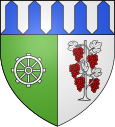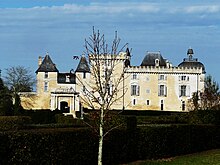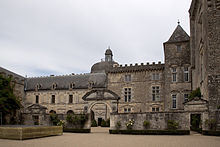Vayres (Gironde)
|
Vayres Vairas |
||
|---|---|---|

|
|
|
| region | Nouvelle-Aquitaine | |
| Department | Gironde | |
| Arrondissement | Libourne | |
| Canton | Le Libournais-Fronsadais | |
| Community association | Libournais | |
| Coordinates | 44 ° 54 ′ N , 0 ° 19 ′ W | |
| height | 2-39 m | |
| surface | 14.46 km 2 | |
| Residents | 3,956 (January 1, 2017) | |
| Population density | 274 inhabitants / km 2 | |
| Post Code | 33870 | |
| INSEE code | 33539 | |
| Website | http://www.mairie-vayres.fr/ | |
 Vayres - Château |
||
Vayres ( Occitan Vairas ) is a southwestern French municipality with 3956 inhabitants (at January 1, 2017) in the department of Gironde in the region Nouvelle-Aquitaine .
location
The place Vayres is on the left, in this case western Dordogne bank at a height of about 20 meters above sea level. d. M. The closest town is Libourne , about ten kilometers (driving distance) to the east ; the city of Bordeaux is about 32 kilometers to the west.
Population development
| year | 1962 | 1968 | 1975 | 1982 | 1990 | 1999 | 2006 | 2017 |
| Residents | 1853 | 1845 | 2295 | 2361 | 2491 | 2631 | 3149 | 3956 |
In the 19th century the community always had between 1,350 and 2,000 inhabitants. The increasing mechanization of agriculture in the first half of the 20th century led to a continuous decline in the number of inhabitants to the lows of just over 1,500 people in the 1930s and 1940s. The proximity to the city of Bordeaux - as a result of the significantly lower property prices in the country - has led to a renewed increase in population in recent decades.
economy
For centuries, Vayres lived from agriculture, which also included viticulture. The wines produced here were previously mainly exported to England via the ports on the Gironde ; The region around Vayres has had its own appellation Graves de Vayres (AOC) since 1937 . The place itself functions to this day as a regional trade, craft and service center. Tourism also plays a certain role in the economic life of the municipality in the form of renting out holiday homes ( gîtes ).
history
The remains of a country estate ( villa rustica ) near the present-day castle date from the Gallo-Roman period . Viticulture in the region also goes back to the Romans. From 1154 to 1453 the area belonged to the area of the Duchy of Guyenne - claimed by the English crown .
Attractions
- Of the originally Romanesque parish church of Saint Jean-Baptiste , only the rather simple portal remains. In the 15th century the church building was renovated in the Gothic style . In the 17th century the dome with a mounted lantern , which is atypical for the region but can also be found as a tower top of the nearby castle, was built . In the 19th century the church building was extended by two aisles to accommodate the growing population of the community.
- The Château de Vayres is about one kilometer northeast of the town on the banks of the Dordogne ( 44 ° 54 ′ 0 ″ N , 0 ° 18 ′ 53 ″ W ). It has a long history: a Gallo-Roman walled oppidum was replaced by an early medieval mound ( moth ) with a wooden palisade border. In a document from 1092 there is already talk of a stone building. In 1288 the castle became the property of Amanieu VII of the Albret family ; his family remained the owners of the castle until the time of Henry IV. In 1326, Bérard d'Albret sided with the English King Edward II ; for he received financial means by which he increased his castle and embellished - from this time, the integrated in today's South Wing keep (still donjon ), with a drawbridge provided Torburg ( châtelet ) and the moat ( douves preserved). During the Hundred Years War (1337-1453) the castle was temporarily in the hands of Gaston de Foix and Cesare Borgia ; However, it came back into the possession of the Albrets. Henry of Navarre inherited the castle from his mother Jeanne d'Albret , but sold it in 1583 to Ogier de Gourgue , the Guyenne's Chancellor of the Exchequer , who invested considerable funds in a partially new building. In the middle of the 17th century, however, the Gourgue family sided with the Fronde ; H. against Cardinal Mazarin and Anna of Austria , who exercised the reign for their still underage son Louis XIV ; in the following power struggles the building was again badly damaged. Around 1700 Jacques-Joseph de Gourgue , the bishop of the nearby bishopric of Bazas , which was dissolved by the Concordat of 1801 , undertook extensive new building measures - it was at this time that it took on its present form. Due to its long (structural) history, the castle is a conglomerate of medieval and modern components - the medieval gate and donjon as well as the younger, completely symmetrically designed residential wing ( corps de logis ) with its central tower, from which a staircase leads to , are to be emphasized The lower floor leads from where the garden ground floor can be reached via a double staircase . The regularly laid out French-style garden, which was completely redesigned in 2012, roughly corresponds to the taste of the time around 1700. The castle has been recognized as a Monument Historique since 1938 .
- Mascaret , a natural phenomenon in the Dordogne, when the tide is high and the tidal range is high, a high wave reaches Vayres that can even be surfed.
Partner municipality
literature
- Le Patrimoine des Communes de la Gironde. Flohic Éditions, Volume 2, Paris 2001, ISBN 2-84234-125-2 , pp. 904-907.
- André Videau: Histoire de Vayres. 2nd édition augmentée, by Jacques Paul. Imprimerie des Quatre Pavilion, Lormont 1985.
Web links
Individual evidence
- ↑ Vayres, Château in the Base Mérimée of the French Ministry of Culture (French)



